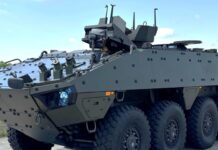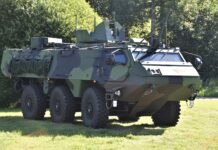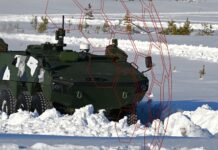At the DSEI Japan 2025 defence exhibition, held at Makuhari Messe in Chiba Prefecture from 21-23 May, Finland’s Patria showcased its NEMO (NEw MOrtar) Container: a turreted 120 mm mortar system mounted on a container.
Meanwhile, starting in Fiscal Year (FY) 2024, the Japan Ground Self-Defense Force (JGSDF) has begun procuring the Type 24 120 mm mobile mortar system: a variant of the Common Tactical Wheeled Vehicle (CTWV). The Type 24 features the 2R2M semi-automatic loading 120 mm mortar system developed by France’s Thales. This 120mm mortar uses the same ammunition as the 120 mm RT: a rifled, towed mortar already in service with the JGSDF.
Given the smoothbore NEMO system’s lack of ammunition compatibility with the 120 mm RT, it is highly unlikely that the NEMO will be adopted as a vehicle-mounted mortar system for the JGSDF. However, Patria intends to propose the NEMO Container to the JGSDF for defence of the islands southwest of Japan, ranging from Kyushu to the Okinawan archipelago.
In April 2025 the Japanese Ministry of Defence (MoD) established the Maritime Transport Group: a joint force of the JGSDF and Japan Maritime Self-Defense Force (JMSDF) that will operate two Medium-size Transport Vessels/Logistics Support Vessels (MTVs/LSVs) with a standard displacement 3,500 tonnes, four Nihombare-class Small Transport Vessels/ Landing Craft Utility (STVs/LCUs) with a standard displacement 2,400 tonnes and four smaller Fast Landing Craft (FLCs), which are 30 m long and 8 m wide, by FY2027.
Patria is offering the NEMO Container for deployment on these vessels as a fire support solution during landing operations and subsequent use as frontline base defence assets.

The NEMO Container is a configuration of the NEMO system mounted in a standard 20 ft (6.1 m) ISO container, with the entire system weighing 11,400 kg.
Patria’s AMV XP 8×8 was adopted as the next-generation wheeled armoured vehicle for the JGSDF in December 2022, with 82 vehicles to be procured by end of FY2025. The initial batch of these vehicles has been imported, while licensed production will be handled by Japan Steel Works, with domestic production scheduled to begin in September 2025. Initially, assembly will begin using imported parts, followed by plans to increase the proportion of Japanese-made parts.













